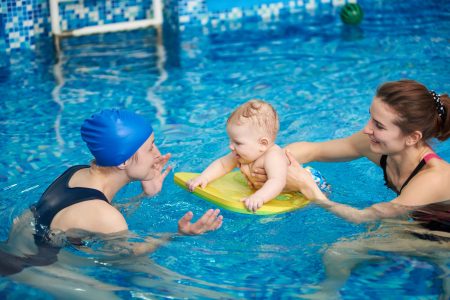

We all love kicking back during a warm summer evening and spending the day at the beach or poolside with family, but do you know about the danger lurking below the water’s surface?
Water poses a significant threat to our children, and it isn’t because of alligators or sharks. According to the CDC, drowning is the second leading cause of death in the United States for children aged one to 14, after motor vehicle crashes. In 2017 alone, drowning claimed the lives of nearly a thousand American children younger than 20 years old. With such considerable danger, parents and guardians must remember the importance of water safety for children.
“Everybody needs to learn how to swim and that includes parents,” said Carol Steiner, MD, FAAP of TPMG James River Pediatrics. Parents and guardians should know at least the basics of swimming and CPR. There are multiple resources for parents looking to teach their children water safety.
Infant Swimming Resource (ISR), for children as old as six months or more, teaches infants how to float and roll over if they were to accidentally fall into the water. While fairly expensive, this resource is extremely valuable for parents with pools or other water hazards near their house. Locally, Riverside offers infant and toddler swim lessons from six months up to three years of age. The YMCA also offers individualized swim lessons as early as age three for members.
Beyond learning to swim, there are other precautions you can take to make sure your little ones remain safe. Instead of floaties that may fall off in the water, Snap-on vests offer children more protection. Some vests even have removable layers of floatation protection that you can adjust according to your child’s strength in the water.
Remember to always wear life jackets on or near boats. For those with home pools or hot tubs, consider installing a four-sided isolation fence that completely surrounds the water with self-closing, self-locking gates. Place door alarms on all access points to the pool.
While proofing your home is important, the best way to make sure your child is safe from drowning is through vigilance. Children, infants, in particular, can drown in bathtubs, buckets, sinks, or even toilets, so it is imperative to maintain attention. Sometimes it may not even be a water source you control. A neighbor’s pool or hot tub is an equally dangerous hazard for a child. Contrary to popular myth, oftentimes juvenile drowning happens silently and as quickly as 20 to 60 seconds. Taking the time to answer a text, read a book, or talk with friends could have disastrous consequences.
Have a talk with your kids about the importance of water safety. Make sure they have a healthy respect for water and understand that drowning can happen at any age. Whether it is a fearless teenager or a curious toddler, all children should understand the risks before they dive in. In the United States, an average of 10 people drown every day. As parents, it is our responsibility to make sure our kids remain safe from the dangers of drowning.
more recommended stories
 Safer Allogeneic Stem Cell Transplants with Treg Therapy
Safer Allogeneic Stem Cell Transplants with Treg TherapyA new preclinical study from the.
 Autoimmune Disorders: ADA2 as a Therapeutic Target
Autoimmune Disorders: ADA2 as a Therapeutic TargetAdenosine deaminase 2 (ADA2) has emerged.
 Kaempferol: A Breakthrough in Allergy Management
Kaempferol: A Breakthrough in Allergy ManagementKaempferol, a dietary flavonoid found in.
 Early Milk Cereal Drinks May Spur Infant Weight Gain
Early Milk Cereal Drinks May Spur Infant Weight GainNew research published in Acta Paediatrica.
 TaVNS: A Breakthrough for Chronic Insomnia Treatment
TaVNS: A Breakthrough for Chronic Insomnia TreatmentA recent study conducted by the.
 First-of-Its-Kind Gene-Edited Pig Kidney: Towana’s New Life
First-of-Its-Kind Gene-Edited Pig Kidney: Towana’s New LifeSurgeons at NYU Langone Health have.
 Just-in-Time Training Improves Success & Patient Safety
Just-in-Time Training Improves Success & Patient SafetyA study published in The BMJ.
 ChatGPT Excels in Medical Summaries, Lacks Field-Specific Relevance
ChatGPT Excels in Medical Summaries, Lacks Field-Specific RelevanceIn a recent study published in.
 Study finds automated decision minimizes high-risk medicine combinations in ICU patients
Study finds automated decision minimizes high-risk medicine combinations in ICU patientsA multicenter study coordinated by Amsterdam.
 Study Discovers Connection Between Omicron Infection and Brain Structure Changes in Men
Study Discovers Connection Between Omicron Infection and Brain Structure Changes in MenA recent study in the JAMA.

Leave a Comment